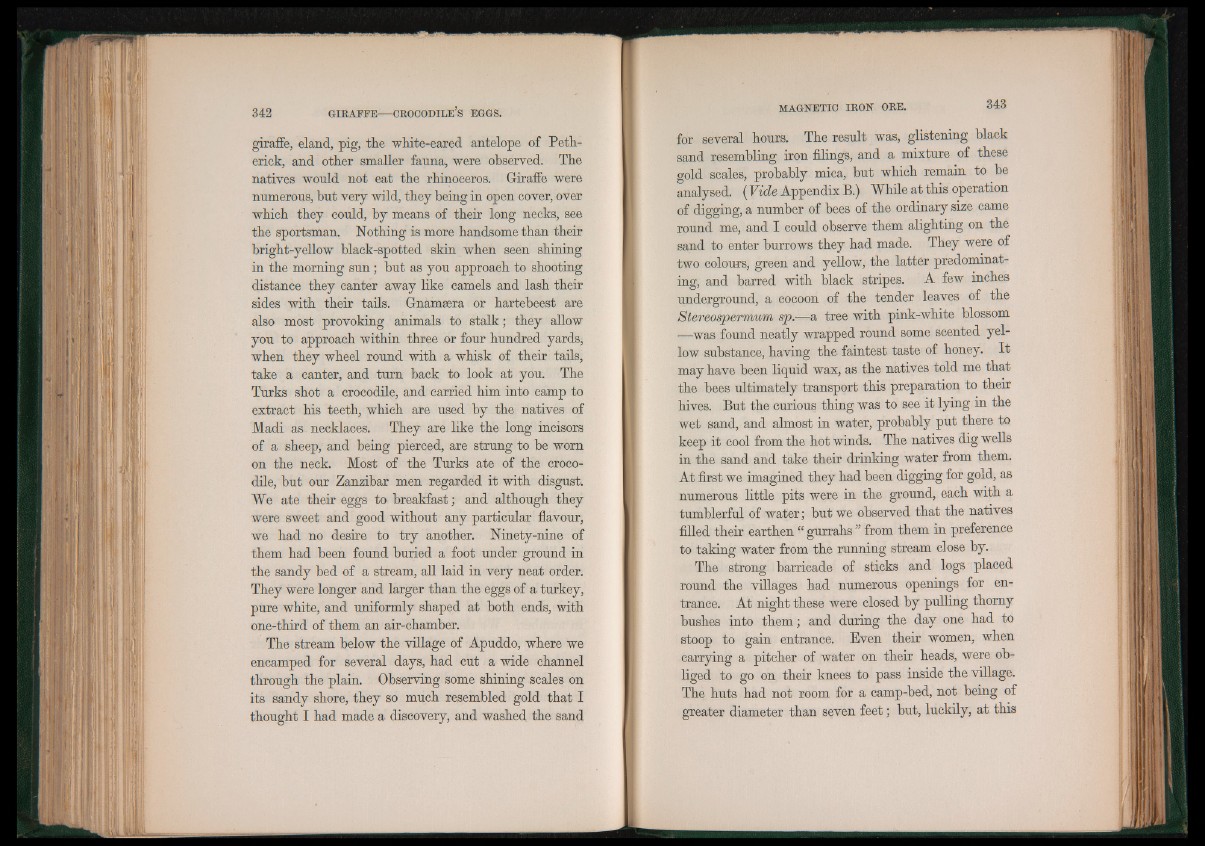
giraffe, eland, pig, the white-eared antelope of Peth-
erick, and other smaller fauna, were observed. The
natives would not eat the rhinoceros. Giraffe were
numerous, but very wild, they being in open cover, over
which they could, by means of their long necks, see
the sportsman. Nothing is more handsome than their
bright-yellow black-spotted skin when seen shining
in the morning sun; but as you approach to shooting
distance they canter away like camels and lash their
sides with their tails. Gnamsera or hartebeest are
also most provoking animals to stalk; they allow
you to approach within three or four hundred yards,
when they wheel round with a whisk of their tails,
take a canter, and turn back to look at you. The
Turks shot a crocodile, and carried him into camp to
extract his teeth, which are used by the natives of
Madi as necklaces. They axe like the long incisors
of a sheep, and being pierced, are strung to be worn
on the neck. Most of the Turks ate of the crocodile,
but our Zanzibar men regarded it with disgust.
We ate their eggs to breakfast; and although they
were sweet and good without any particular flavour,
we had no desire to try another. Ninety-nine of
them had been found buried a foot under ground in
the sandy bed of a stream, all laid in very neat order.
They were longer and larger than the eggs of a turkey,
pure white, and uniformly shaped at both ends, with
one-third of them an air-chamber.
The stream below the village of Apuddo, where we
encamped for several days, had cut a wide channel
through the plain. Observing some shining scales on
its sandy shore, they so much resembled gold that I
thought I had made a discovery, and washed the sand
for several hours. The result was, glistening black
sand resembling iron filings, and a mixture of these
gold scales, probably mica, but which remain to be
analysed. ( Vide Appendix B.) While at this operation
of digging, a number of bees of the ordinary size came
round me, and I could observe them alighting on the
sand to enter burrows they had made. They were of
two colours, green and yellow, the latter predominating,
and barred with black stripes. A few inches
underground, a cocoon of the tender leaves of the
Stereospermum sp.—a tree with pink-white blossom
—was found neatly wrapped round some scented yellow
substance, having the faintest taste of honey. I t
may have been liquid wax, as the natives told me that
the bees ultimately transport this preparation to their
hives. But the curious thing was to see it lying in the
wet sand, and almost in water, probably put there to
keep it cool from the hot winds. The natives dig wells
in the sand and take their drinking water from them.
At first we imagined they had been digging for gold, as
numerous little pits were in the ground, each with a
tumblerful of water; but we observed that the natives
filled their earthen “ gurrahs ” from them in preference
to taking water from the running stream close by.
The strong barricade of sticks and logs placed
round the villages had numerous openings for entrance.
At night these were closed by pulling thorny
bushes into them; and during the day one had to
stoop to gain entrance. Even their women, when
carrying a pitcher of water on their heads, were obliged
to go on their knees to pass inside the village.
The huts had not room for a camp-bed, not being of
greater diameter than seven feet; but, luckily, at this